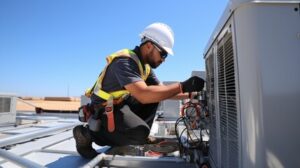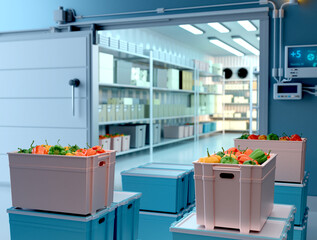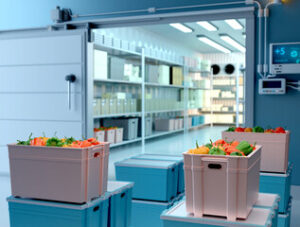Heating, ventilation, and air conditioning (HVAC) systems have evolved significantly over the years. Modern advancements have improved energy efficiency and indoor air quality. Smart technology has allowed for better control and monitoring of HVAC performance. These improvements have enhanced comfort and reduced operational costs.
Variable refrigerant flow (VRF) technology has transformed HVAC efficiency. This system adjusts refrigerant flow based on specific zone requirements. It reduces energy consumption by only delivering what is needed. VRF systems also provide precise temperature control and quick adjustments. Contact Ausco Air Heating & Air Conditioning for professional help.
Smart thermostats have introduced a new level of convenience. They adapt to user preferences and adjust settings automatically. Machine learning enables them to anticipate heating and cooling needs. This reduces energy waste and enhances overall comfort.
HVAC systems now use zoning to customize temperature control. Separate zones allow different areas to maintain unique settings. This improves comfort and reduces energy usage. Zoning systems are especially effective in larger spaces with varying temperature needs.
Advanced air purification systems have improved indoor air quality. High-efficiency particulate air (HEPA) filters capture tiny pollutants and allergens. Ultraviolet (UV) light technology neutralizes bacteria and viruses. These systems promote healthier indoor environments.
Heat recovery ventilation (HRV) systems maximize energy efficiency. They capture heat from exhaust air and use it to precondition incoming air. This reduces the load on heating and cooling systems. HRV systems improve ventilation without increasing energy costs.
Ductless mini-split systems have become popular for their flexibility. They require no ductwork and can be installed in various configurations. Individual units allow for separate temperature control in different rooms. This design reduces energy loss and enhances comfort.
Geothermal heat pumps have gained traction for their sustainability. They use the earth’s constant underground temperature for heating and cooling. This approach reduces reliance on fossil fuels and lowers operating costs. Geothermal systems provide consistent performance year-round.
HVAC systems have adopted inverter technology for improved efficiency. Inverters adjust compressor speed based on demand. This reduces energy spikes and enhances performance consistency. Inverter systems are quieter and more energy-efficient than traditional models.
Desiccant dehumidification has improved moisture control. Desiccant materials absorb moisture from the air, reducing humidity levels. This improves comfort and prevents mold growth. Desiccant systems are especially effective in humid climates.
Hydronic heating systems use water to transfer heat. Heated water circulates through pipes or radiators to warm spaces. This method provides even, consistent heating. Hydronic systems are energy-efficient and reduce airborne dust and allergens.
Ice storage systems have introduced new cooling methods. These systems produce ice during off-peak hours and use it to cool buildings later. This reduces electricity demand during peak hours. Ice storage improves overall cooling efficiency.
Energy recovery ventilators (ERV) have enhanced air exchange efficiency. ERVs transfer both heat and moisture between exhaust and intake air. This maintains comfortable humidity levels while improving energy efficiency. ERVs are ideal for maintaining balanced indoor air quality.
HVAC systems now incorporate smart diagnostics for faster maintenance. Embedded sensors monitor system performance in real-time. Automated alerts notify technicians of potential issues. This reduces downtime and extends the lifespan of HVAC equipment.
Advanced duct sealing methods have minimized air leaks. Aerosealing technology distributes a sealant inside ducts to close gaps. This improves airflow and reduces energy loss. Proper duct sealing enhances overall HVAC system performance.
Hybrid HVAC systems combine traditional and renewable energy sources. They switch between gas, electric, and solar power based on efficiency. This reduces reliance on nonrenewable energy. Hybrid systems optimize performance while lowering operational costs.
Radiant floor heating has become a popular option for comfort. Heated coils or pipes beneath the floor surface distribute heat evenly. This eliminates cold spots and reduces heat loss. Radiant floor systems improve heating efficiency and comfort.
HVAC systems now use demand-controlled ventilation (DCV) for better air quality. DCV adjusts ventilation rates based on occupancy and carbon dioxide levels. This reduces energy use during low-occupancy periods. DCV systems improve efficiency and indoor comfort.
High-efficiency heat pumps have improved seasonal performance. Modern heat pumps operate effectively even in extreme temperatures. Variable-speed technology adjusts output based on demand. This enhances comfort while minimizing energy consumption.
Duct insulation has improved to reduce energy loss. High-performance insulation materials prevent heat transfer through ducts. This maintains consistent air temperature and reduces system strain. Proper insulation supports energy efficiency and comfort.
Evaporative cooling systems have gained popularity in dry climates. These systems use water to cool the air through evaporation. They consume less energy than traditional air conditioning. Evaporative cooling improves comfort while lowering costs.
HVAC systems now use environmentally friendly refrigerants. New refrigerants have a lower global warming potential (GWP). This reduces the environmental impact of HVAC operations. Eco-friendly refrigerants comply with modern environmental standards.
Advanced air balancing techniques have improved system efficiency. Proper balancing ensures even airflow across all zones. This reduces hot and cold spots and improves comfort. Balanced airflow also enhances HVAC equipment lifespan.
Magnetic bearing chillers have introduced new cooling technology. These systems use magnetic fields to suspend the compressor shaft. This eliminates friction and reduces energy loss. Magnetic chillers operate quietly and with high efficiency.
HVAC systems now incorporate predictive maintenance technology. Machine learning algorithms analyze performance data to predict failures. This allows for timely repairs and prevents major breakdowns. Predictive maintenance reduces repair costs and improves reliability.
Demand response programs have improved energy efficiency. Smart HVAC systems adjust power consumption based on grid demand. This reduces strain on the electrical grid during peak hours. Demand response supports overall energy stability.
Air source heat pumps have become more versatile. They extract heat from outdoor air for heating and cooling. Modern models operate efficiently even in colder climates. Air source heat pumps provide year-round comfort with low energy use.
HVAC zoning with smart controls has improved temperature regulation. Smart dampers adjust airflow based on room requirements. This allows for independent climate control across different zones. Zoning systems improve efficiency and comfort.
Modern HVAC systems integrate with home automation platforms. Voice control and mobile apps allow users to adjust settings remotely. Automation improves convenience and optimizes energy use. Smart integration enhances the overall user experience.
HVAC systems now incorporate noise reduction technology. Sound-dampening materials and quiet fan motors reduce operational noise. This improves comfort without compromising performance. Quiet operation enhances the overall indoor environment.
Smart air quality monitors have improved health and comfort. These devices track pollution, humidity, and temperature levels. Real-time data allows for immediate adjustments. Smart monitoring supports cleaner and healthier indoor air.
HVAC systems now use carbon dioxide-based refrigerants. These refrigerants have low environmental impact and high efficiency. CO2-based systems operate effectively under various conditions. This solution supports sustainable HVAC practices.
High-efficiency air handlers have improved ventilation performance. Variable-speed motors adjust airflow based on demand. This reduces energy consumption and improves air distribution. Efficient air handlers enhance overall HVAC performance.
Thermal energy storage systems have introduced new cooling methods. These systems store excess cooling energy for later use. Stored energy is used during peak demand periods. Thermal storage reduces strain on HVAC systems and lowers energy costs.
UV-C light technology has enhanced air sanitation. UV-C lamps installed in HVAC systems kill bacteria, mold, and viruses. This improves air quality and reduces health risks. UV-C technology supports cleaner and safer indoor environments.
Hydronic cooling systems have gained traction for their efficiency. These systems circulate chilled water through pipes to cool spaces. Hydronic cooling reduces energy consumption and noise levels. This method provides consistent and comfortable cooling.
HVAC systems have improved condensate management techniques. Advanced drainage systems prevent water buildup and damage. Self-cleaning drain lines reduce maintenance needs. Effective condensate management improves system reliability.
Smart HVAC systems now use weather forecasting for better performance. Systems adjust heating and cooling based on expected weather patterns. This reduces energy waste and improves comfort. Weather-based adjustments enhance overall efficiency.
HVAC systems continue to evolve with new materials, smart technology, and sustainable practices. The integration of advanced control systems and efficient components has improved performance and user satisfaction. Modern HVAC solutions reflect a balance of comfort, efficiency, and environmental responsibility.





 Commercial Refrigerators
Commercial Refrigerators